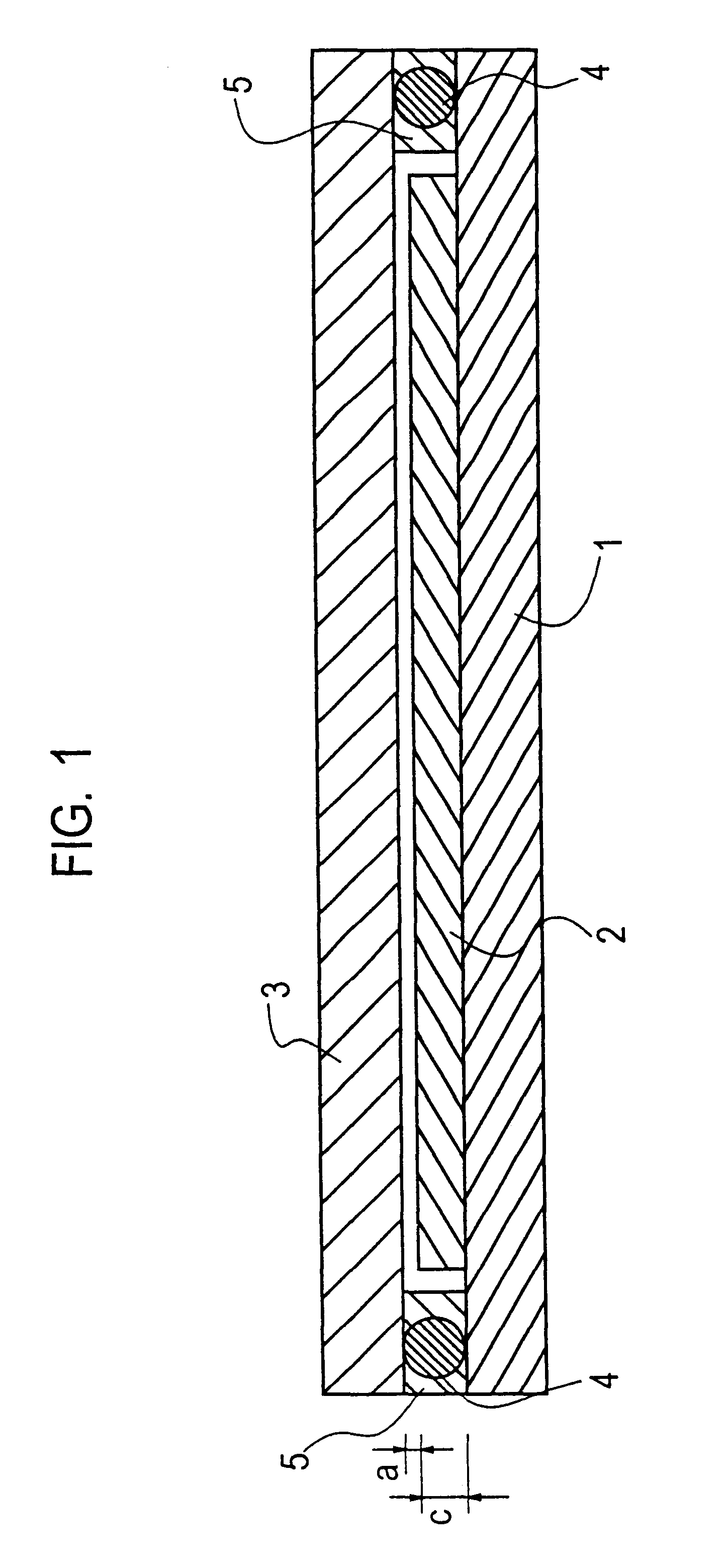Organic electroluminescent device
a technology of electroluminescent devices and organic el, which is applied in the direction of discharge tube luminescnet screens, natural mineral layered products, etc., can solve the problems of inability to maintain consistent light emission, acutely sensitive to moisture, and non-light emission spots called dark spots
- Summary
- Abstract
- Description
- Claims
- Application Information
AI Technical Summary
Benefits of technology
Problems solved by technology
Method used
Image
Examples
experiment 1
A commercially available ultraviolet curing type epoxy resin adhesive agent 30Y296D (100 mg, made by Three Bond) in an uncured state was coated on a substrate of glass 7059 (made by Corning). Another glass 7059 (Corning) serving as a sealing plate was put over the substrate. Then, they were pressurized at a pressure of 3 kg / cm.sup.2 while they were ground together, thereby forming a thin adhesive agent layer between the glass substrate and the glass sealing plate. At this time, 7 .mu.m spacers (1 wt %) were dispersed in the adhesive agent to obtain an adhesive agent layer of 7 .mu.m in thickness. Then, the adhesive agent surface was irradiated through the glass substrate with ultraviolet light from a metal halide lamp and in an integral light quantity of 600 mJ, thereby curing the adhesive agent. After curing, the sealing plate was peeled off the glass substrate to expose the bonded surface to view, from which the adhesive agent (about 50 mg) was scratched off. The thus obtained sam...
experiment 2
A sample was analyzed as in Experiment 1 with the exception that an adhesive agent containing a metallocene compound as a reaction initiator was used for a comparative adhesive agent sample. As a result, the total amount of gases generated from the comparative adhesive agent sample after ultraviolet curing was a very large value of 217 .mu.g / g.
example 1
An organic EL device was prepared using the inventive sample employed in Experiment 1.
A glass substrate was provided thereon with an 85 nm-thick ITO transparent electrode (hole injecting electrode) in such a way that pixels (280.times.280 .mu.m per pixel) were patterned on the ITO transparent electrode according to an array of 64 dots.times.7 lines. Then, the substrate with the patterned hole injecting electrode formed on it was ultrasonically washed with neutral detergent, acetone, and ethanol, and then pulled up from boiling ethanol, followed by drying. The substrate was subsequently cleaned on its surface with UV / O.sub.3. Then, the substrate was fixed to a substrate holder in a vacuum evaporation system, which was evacuated to a vacuum of 1.times.10.sup.-4 Pa or lower. 4,4',4"-tris(-N-(3-methylphenyl)-N-phenylamino)triphenylamine (m-MTDATA) was deposited by evaporation at a deposition rate of 0.2 nm / sec. to a thickness of 40 nm, thereby forming a hole injecting layer. With the va...
PUM
| Property | Measurement | Unit |
|---|---|---|
| voltage | aaaaa | aaaaa |
| temperature | aaaaa | aaaaa |
| glass transition temperature | aaaaa | aaaaa |
Abstract
Description
Claims
Application Information
 Login to View More
Login to View More - R&D
- Intellectual Property
- Life Sciences
- Materials
- Tech Scout
- Unparalleled Data Quality
- Higher Quality Content
- 60% Fewer Hallucinations
Browse by: Latest US Patents, China's latest patents, Technical Efficacy Thesaurus, Application Domain, Technology Topic, Popular Technical Reports.
© 2025 PatSnap. All rights reserved.Legal|Privacy policy|Modern Slavery Act Transparency Statement|Sitemap|About US| Contact US: help@patsnap.com


